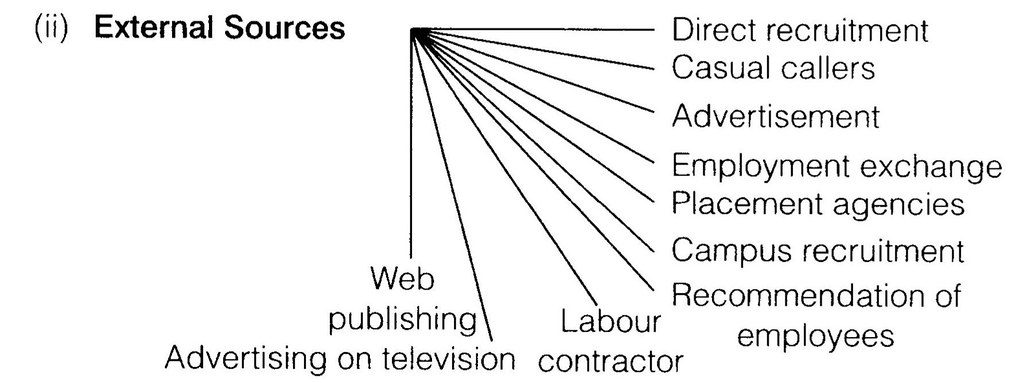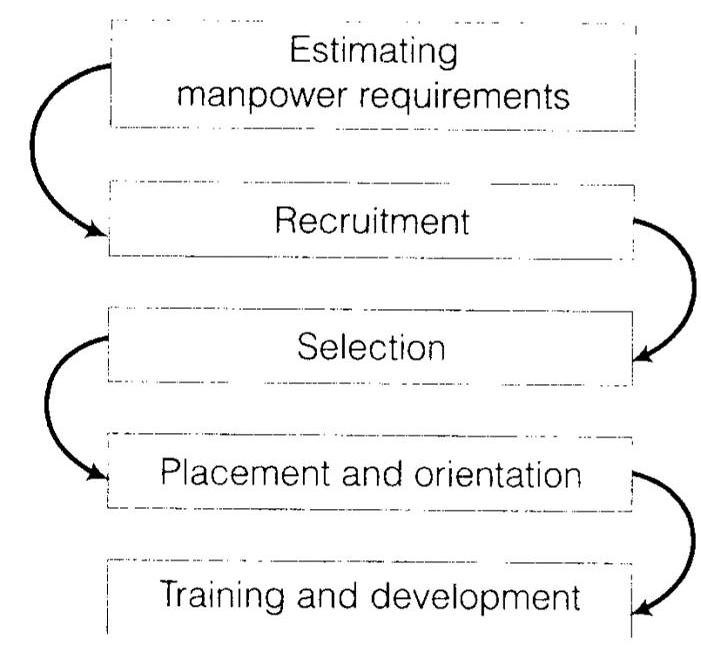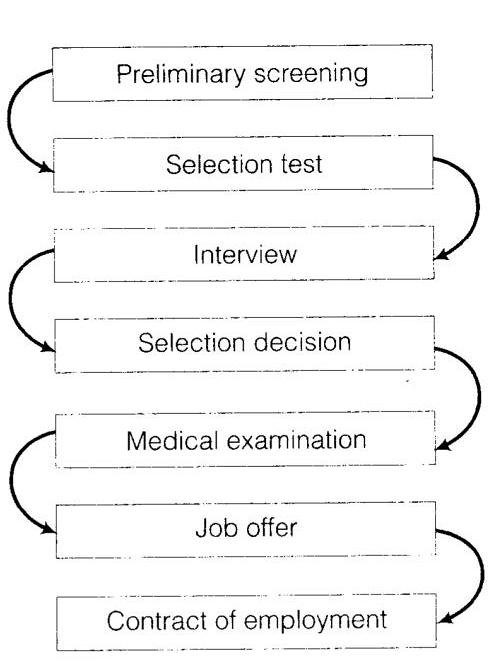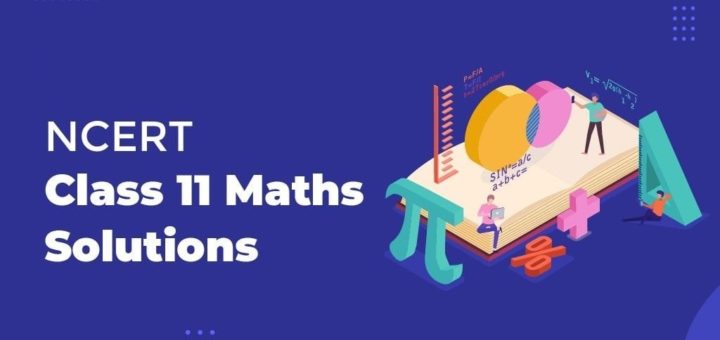Short Answer Type Questions
1. Briefly enumerate the important sources of recruitment.
Ans: There are two important sources of recruitment
When the firm arranges for manpower from within the organisation then it is known as an internal source. These are of two types
(a) Transfer When we move an employee from one department to the other, from one branch to the other, from one division to another which leads to a change in his/her working environment it is known as a transfer. There is hardly any change in his authority and responsibility.
(b) Promotion When we move an employee to a higher level in the same department, branch, division or different department, branch or division which increases his authority, responsibility and status, it is known as a promotion.
from any of the above given sources, it is known as external sources of recruitment.
2. What is meant by recruitment? How is it different from selection?
Ans: Recruitment refers to the process of finding possible candidates for a job. It can be defined as the process of motivating and encouraging people to come and apply for a job in an organisation. Selection is the process of identifying and choosing the best person out of a number of prospective candidates for a job.
If recruitment is positive, selection is negative. Recruitment helps in creating a pool of prospective workforce whereas selection helps in finding the best out of them.
3. Define training. How is it different from education?
Ans: Training is the systematic development of knowledge, skills and attitudes required by an individual to perform adequately a given task or job.
4. Distinguish between training and development.
Ans: Difference between training and development
5. Why are internal sources of recruitment considered to be more economical?
Ans: Filling of jobs internally is cheaper as compared to getting candidates from external sources because only transfer or promotion has to be done. It does not involve the long process of staffing or selection. It increases the cost in the form of more time, money and efforts in recruiting.
6. What is the importance of staffing function in today’s environment?
Ans: Staffing is considered to be a key function because it deals with human resource, which is regarded as one of the most valuable resource of any organisation. Once an organisation could place the right man at the right job, it is easy to plan, organise, co-ordinate, direct and control the human activities to get the desired results. It helps in discovering and obtaining competent personnel, ensures the continuous survival and growth, helps to ensure optimum utilisation of resources and improves job satisfaction as well.
Long Answer Type Questions
1. Define the staffing process and the various steps involved in it.
Ans: Staffing process of the management is concerned with acquiring, developing, employing, remunerating and retaining people or we can say it is the timely fulfilment of the manpower requirements with in an organisation.
The following steps are involved in staffing process
(i) Estimating the Manpower Requirements The first step in the staffing process is determining the present manpower inventory and assessing the present and future manpower requirements of the organisation keeping in mind the production schedule, demand etc.
(ii) Recruitment Recruitment may be defined as the process of searching for prospective employees and stimulating them to apply for jobs in the organisation. For this various sources can be used like transfer, promotion, advertising, job consultants etc.
(iii) Selection Selection is the process of choosing from among the pool of the prospective job candidates developed at the stage of recruitment. It involves a host of tests and interviews.
(iv) Placement and Orientation Orientation is introducing the selected employee to other employees and familiarising him with the rules and policies of the organisation. He is taken around the work place and given the charge of the job for which he has been selected. Placement refers to the employee occupying the position or post for which the person has been selected.
(v) Training and Development All organisations have either in-house training centres or have forged alliances with training and educational institutes to ensure continued learning of their subordinates. By offering the opportunities for career advancement to their members, organisations are not only able to attract but also retain its talented staff.
(vi) Performance Appraisal After the employees have undergone a period of training and they have been on the job for some time, there is a need to evaluate their performance. The employee is expected to know what the standards are and the superior is to provide the employee feedback on his/her performance. The performance appraisal process, therefore, will include defining the job, appraising performance and providing feedback.
(vii) Promotion and Career Planning It is very important for all organisations to address career related issues and promotional avenues for their employees. They must provide opportunities to everyone to show their potential and in return promotions can be provided.
(viii) Compensation All organisations need to establish wage and salary plans for their employees. There are various ways to prepare different pay plans depending on the worth of the job. Compensation therefore, refers to all forms of pay or rewards going to employees.
2. Explain the procedure for selection of employees.
Ans: The important steps in the process of selection are as follows
(i) Preliminary Screening It helps the manager eliminate unqualified or unfit job seekers based on the information supplied in the application forms.
(ii) Selection Tests An employment test is a mechanism that attempts to measure certain characteristics of individuals. These range from aptitudes, such as manual dexterity, to intelligence to personality.
(iii) Employment Interview Interview is a formal, in depth conversation conducted to evaluate the applicant’s suitability for the job.
(iv) Reference and Background Checks Many employers request names, addresses and telephone numbers of references for the purpose of verifying information and gaining additional on an applicant.
(v) Selection Decision The final decision has to be made among the candidates who pass the tests, interviews and reference checks.
(vi) Medical Examination Before the candidate is given a job offer he/she is required to go through a medical test.
(vii) Job Offer Job offer is made through a letter of appointment/confirm his acceptance. Such a letter generally contains a date by which the appointee must report on duty.
(viii) Contract of Employment After the job offer has been made and candidate accepts the offer, certain documents need to be executed by the employer and the candidate. There is also a need for preparing a contract of employment. It includes job title, duties, responsibilities, date when continuous employment starts etc.
3. What are the advantages of training to the individual and to the organisation?
Ans: Training helps both the organisation and the individual.
Benefits to the Organisation
(i) Training is a systematic learning which reduces the wastage of efforts and money.
(ii) Enhances employee productivity.
(iii) Training helps a manager to handle an emergency situation.
(iv) Training motivates workers and thus reduces absenteeism.
(v) Helps in adjusting to the changing environment (technological).
Benefits to the Employee
(i) Better career opportunities due to improved skills and knowledge.
(ii) Earnings can be increased due to improved performance.
(iii)Trained workers can handle machines more efficiently.
(iv) Employees always remain motivated and satisfied.
4. The staffing function is performed by every manager and not necessarily by a separate department. Explain.
Ans: Staffing is a function which all managers need to perform. It is the responsibility of all managers to directly deal with and select people to work for the organisation. When the manager performs the staffing function his role is slightly limited. In small organisations, managers may perform all duties related to employees salaries, welfare and working conditions but as organisation grow and number of persons employed increases, a separate department called the human resource department is formed which has specialists in managing people.
Case Problems
1.A company X limited is setting up a new plant in India for – manufacturing auto components. India is a highly competitive and cost effective production base in this sector. Many reputed car manufacturers source their auto components from here. X limited is planning to capture about 40% of the market share in India and also export to the tune of at least $ 5 million in about 2 years of its planned operations. To achieve these targets it requires a highly trained and motivated work force. You have been retained by the company to advise it in this matter. While giving answer keep in mind the sector, the company is operating .
1. Outline the process of staffing the company should follow.
Ans: X Ltd is planning to set up new plant in India for manufacturing auto components. The prime concern of the company is to hire the manpower who are highly trained and motivated. In order to achieve the targets, the company should follow the staffing process in this manner.
2. Which sources of recruitment the company should rely upon? Give reasons for your recommendation.
Ans: The company is establishing a new unit in India. Thus, they should rely on external sources of recruitment. They should adopt this source and through employment exchange, placement agencies, labour contractors they will able to get the good staff in company.
This recommendation is fruitful because through these sources the company is having a wide choice of candidates, they can get the qualified personnel and brings new blood in the organisation who are highly competitive, will work harder to show better performance.
3. Outline the process of selection the company should follow with reasons.
Ans: Through recruitment process organisation receive large number of applications. In order to select the most suitable candidate to perform the job. Selection process is to be considered. Following steps are to be taken
Company should follow these steps in series as the first step preliminary screening helps the manager to select among those candidates whose applications are selected.
Second step is selection test it is to be conducted to check the practical knowledge of the candidate.
Third step interview is to be taken of those candidates who qualify the test. A panel of experts is called which are identifying the best among hundreds.
Fourth step is selection decision. The candidates who pass the test, interview included in selection list and critically examined that they are best or not.
Fifth step is examining their medical fitness they are efficient or not.
Sixth step is to offer the job, providing them a letter of appointment in which terms and conditions are mentioned.
The final step is contract of employment when candidate accepts the job offer they signed the contract of employment, the employer and candidate exchange certain documents.
4. Which methods of training and development should be company initiate? Explain giving reasons.
Ans: The company can use ‘On the job’ and ‘Off the job’ training methods.
The merits or benefits of ‘On the job’ are
(i) It is a practical method.
(ii) The trainee can contribute towards the real/actual work.
(iii) Separate arrangements need not be done.
If the ‘Off the job’ methods are used then the benefits derived are
(i) Vestibule training helps in avoiding modern and expensive equipmens from being damaged.
(ii) Conference helps in to develop conceptual knowledge reduce, resistance to change etc.
2. A major insurance company handled all recruiting screening
and traning processes for data entry/customer service representatives. Their competitor was attracting most of the ,
qualified, potential employees in their market. Recruiting was made even more difficult by the strong economy and the ‘job seeker’s market.’ This resulted in the client having to choose from candidates who had the ‘soft’ skills needed for the job, but lacked the proper ‘hard’ skills and training.
1. As an HR manager what problems do you see in the company?
Ans: The human resource manager may face the following problems
(i) Lack of trained workforce.
(ii) Lack of sufficient personnel to provide customer services.
(iii) Inefficient maintenance of data.
2. How do you think it can be resolved?
Ans: Following steps can be taken to resolve these problems
(i) Proper training of the personnel.
(ii) Provision of incentive based schemes.
(iii) Proper data base should be maintained by the company in order to provide efficient services.
3.A public transport corporation has hired 1,000 buses for the different routes for the passengers of metropolitan city. Most of
the 3,000 crewmen (drivers, conduct, helpers etc) of these buses have been found to be wanting in satisfactorily dealing with public and daily commuter. They seem to be little interested in the job and the job seem to have lost all meaning to them.
1. As manager of the public transport company what measures do you suggest to improve the working of crewman in question?
Ans: The following measures can be taken to improve the working of crewmen.
(i) Along with wages/salary various other facilities should be provided to them like education for their children, insurance etc.
(ii) Working hours should be between 7 to 8 per day.
(iii) Intervals should be provided.
2. Is it possible to modify their behaviour by planning a suitable type of training? Suggest one.
Ans: Yes, it is possible to modify their behaviour by planning ‘coaching’ training programme as in this programme superior guides and instruct the trainee as a coach. He suggests the changes required in behaviour and performance of the employee. Coach gives due importance to the objective of individual and objectives of organisation. Thus, effective coaching motivates the employees to perform their best ability.
4. Ms Jayshree recently completed her post graduate diploma in human resource management. A few months from now a large steel manufacturing company appointed her as its human resource manager. As of new, the company employs 800 persons and has an expansion plan in hand which may required another 200 persons for various types of additional requirements. Ms Jayshree has been given complete charge of the company’s human resource department.
1. Point out what functions is she supposed to perform?
Ans: Ms Jayshree as HR manager is required to perform the following functions
(i) Recruitment
(ii) Prepare job description
(iii) Preparing compensation and incentive plans
(iv) Arranging training programmes
(v) Making welfare schemes for employees
(vi) Handling grievances of employees
(vii) Handling labour dispute
2. What problems do you foresee in her job?
Ans: She may face the following problems
(i) Properly qualified candidates may not be available.
(ii) Demand for wages may go higher.
(iii) After providing training the workers may leave the organisation.
(iv) Trade unions may bring unreasonable demands.
3. What steps is she going to take to perform her job efficiently?
Ans: Following steps can be taken by her to perform her job efficiently
(i) She should make use of all the possible sources of recruitment.
(ii) She should frequently consult the experts and also observe the policies followed by competitors to recruit and retain the workforce.
(iii) Maintaining cordial relationship with trade unions and encouraging them to act as one big family.
4. How significant is her role in the organisation?
Ans: Her role in very significant in the organisation. She is a human resources manager and concerned with timely procurement of competent manpower and ensuring its effective and efficient utilisation so as to survive along with the three main objectives; organisational, individual and societal.









